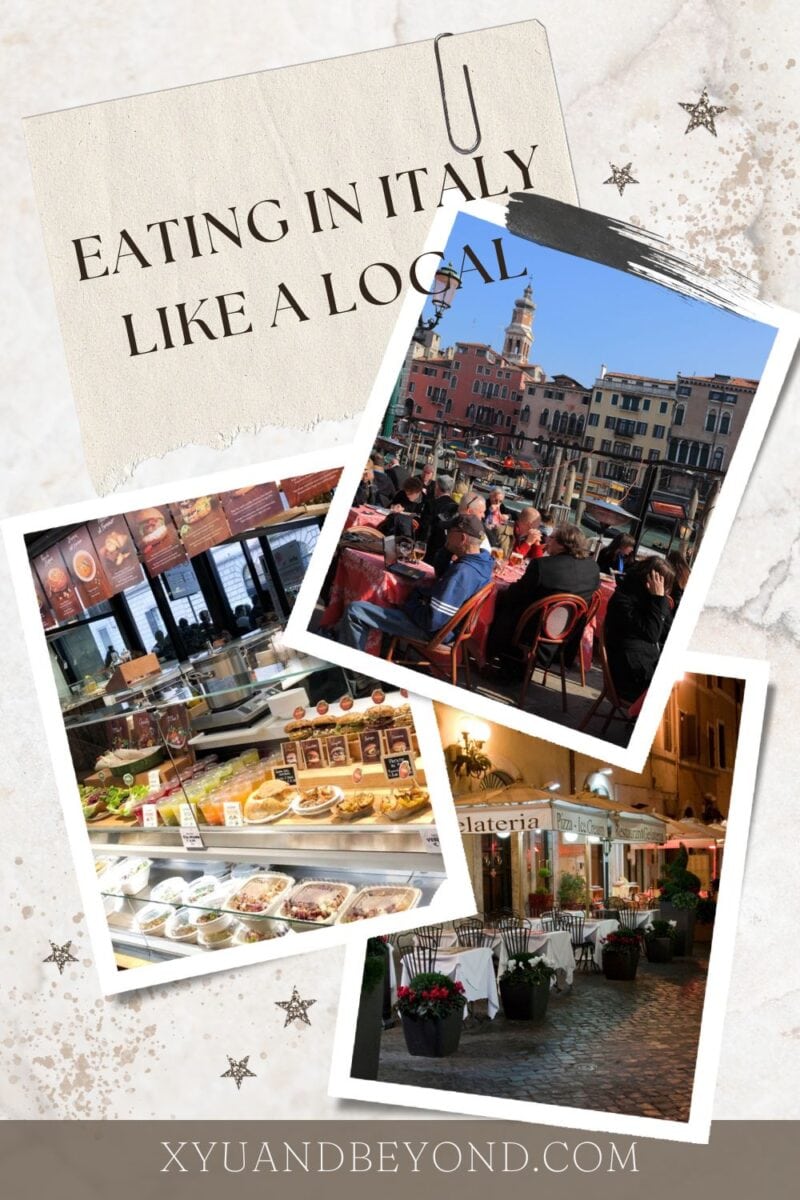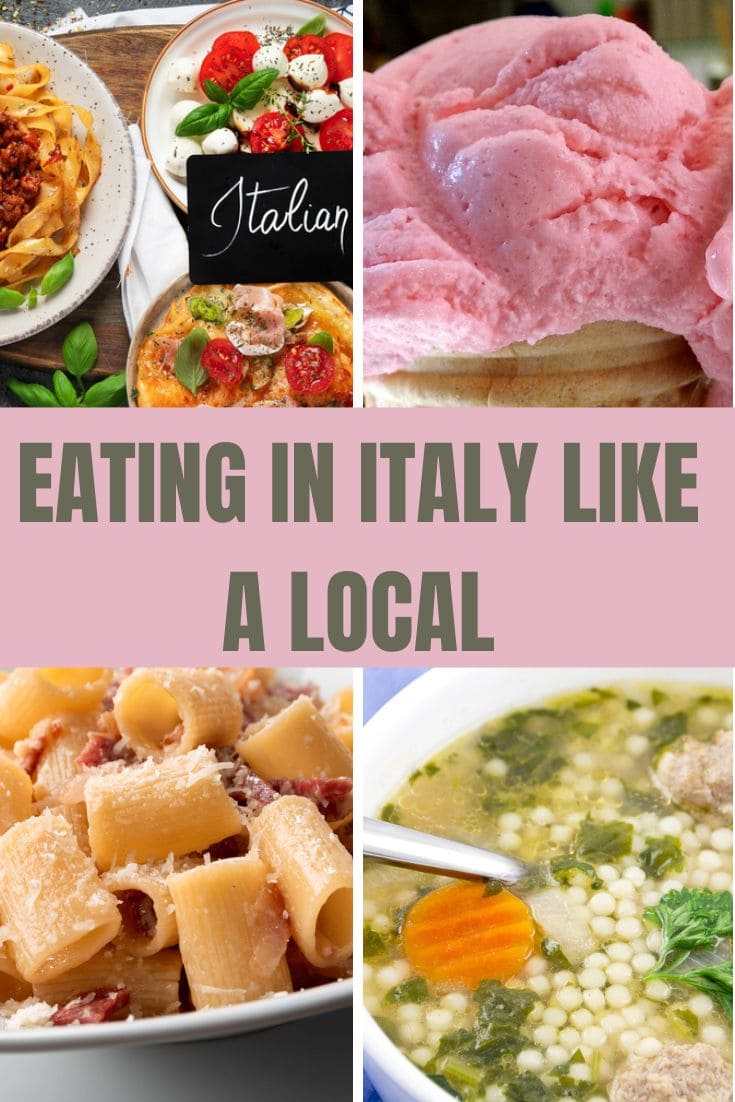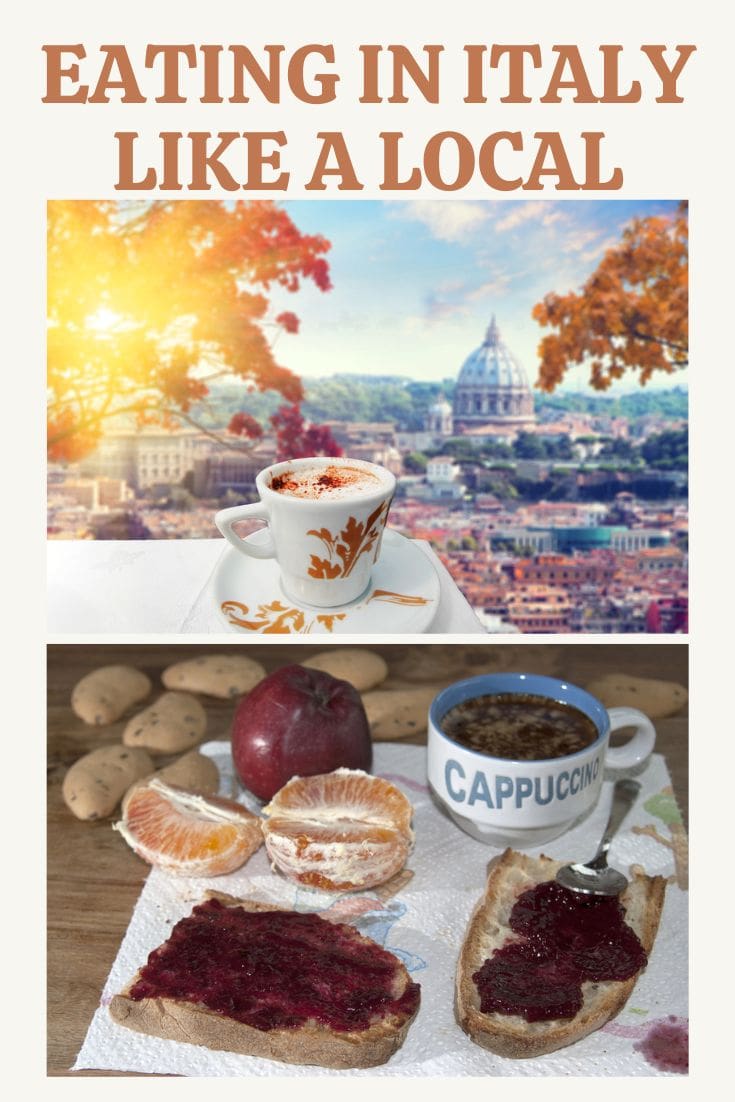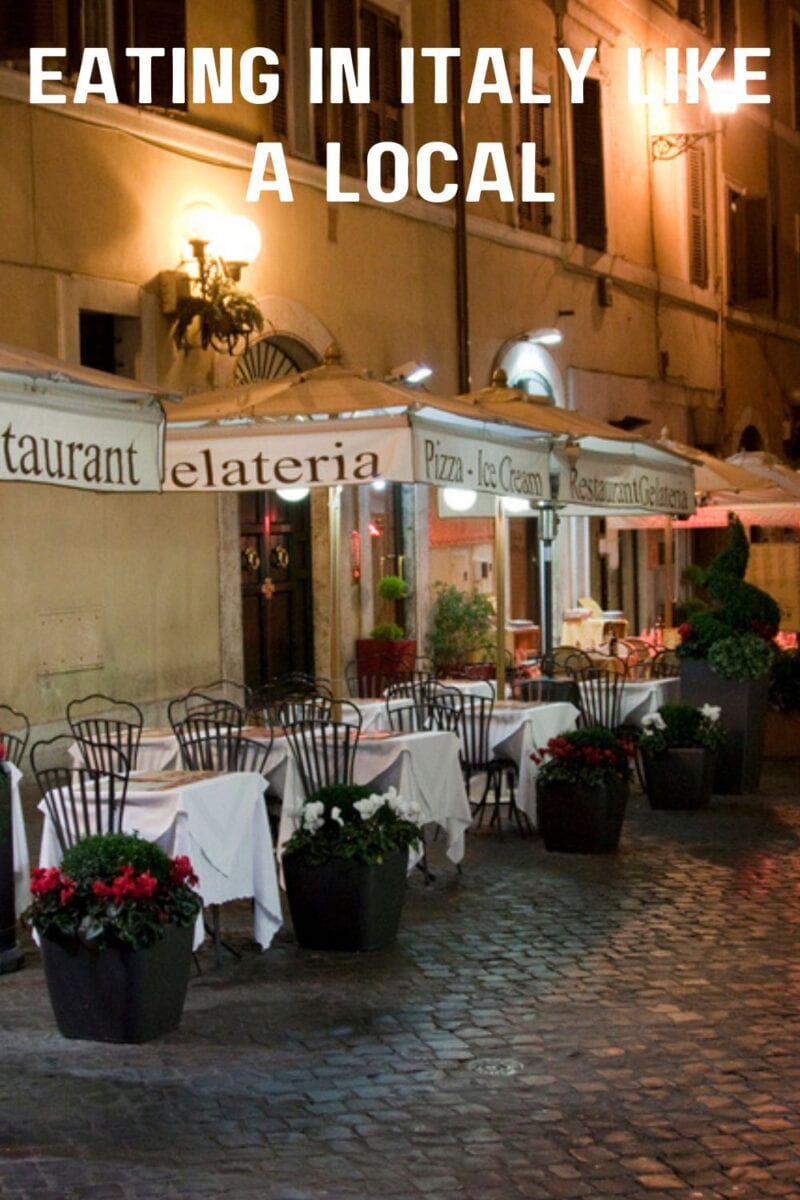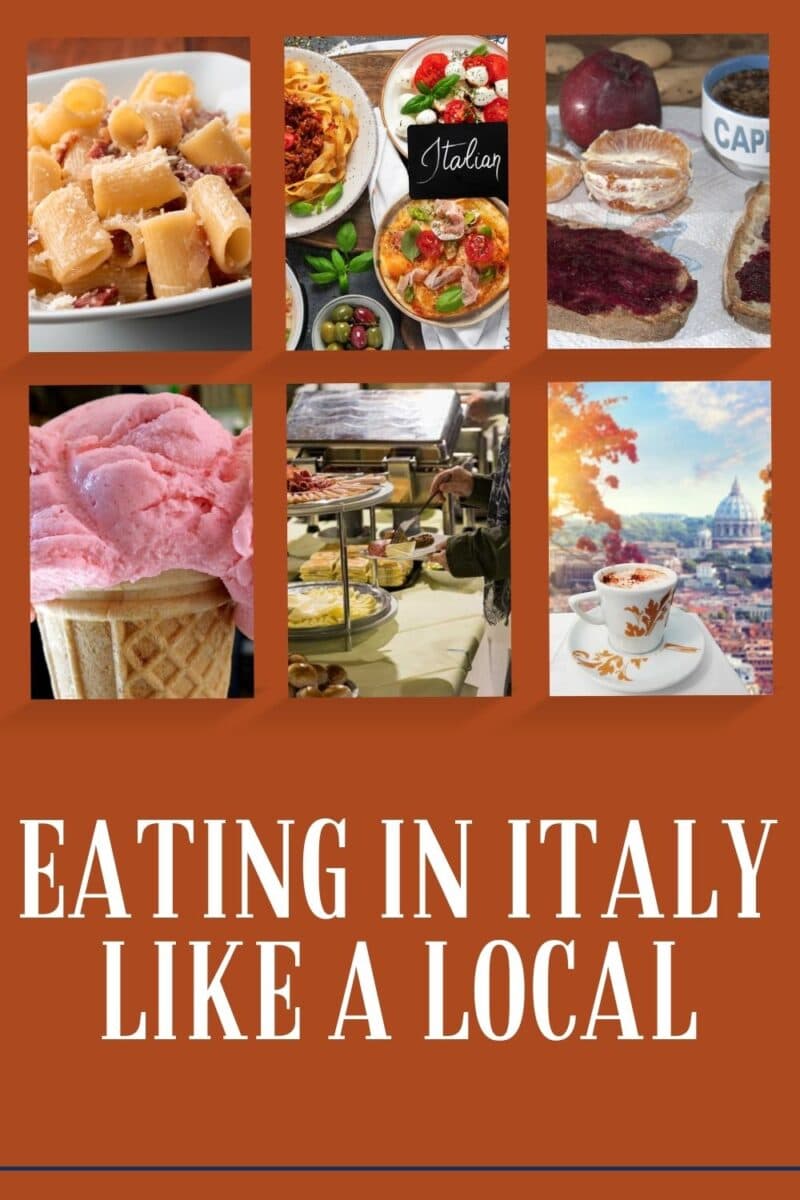Eating in Italy: 26 Tips for Eating the Italian Way
Italian food culture, unlike North America, is centuries old and there are distinct “rules” to eating in Italy. Not only are there distinct rules but Italian cuisine is one of the most interesting in the world. One fun fact about Italian food is that tomatoes are not native to Italy, and another is that (not surprisingly) Italians eat over 51 lbs of pasta a year.
Italy is renowned for its delicious cuisine, making it a dream destination for food lovers. While dining in Italy, it’s important to embrace the local culture and traditions to truly experience the country’s culinary delights. Eating like a local in Italy goes beyond just tasting the food – it involves immersing yourself in the rich gastronomic heritage of the country. A meal in Italy is an experience – relax and enjoy.
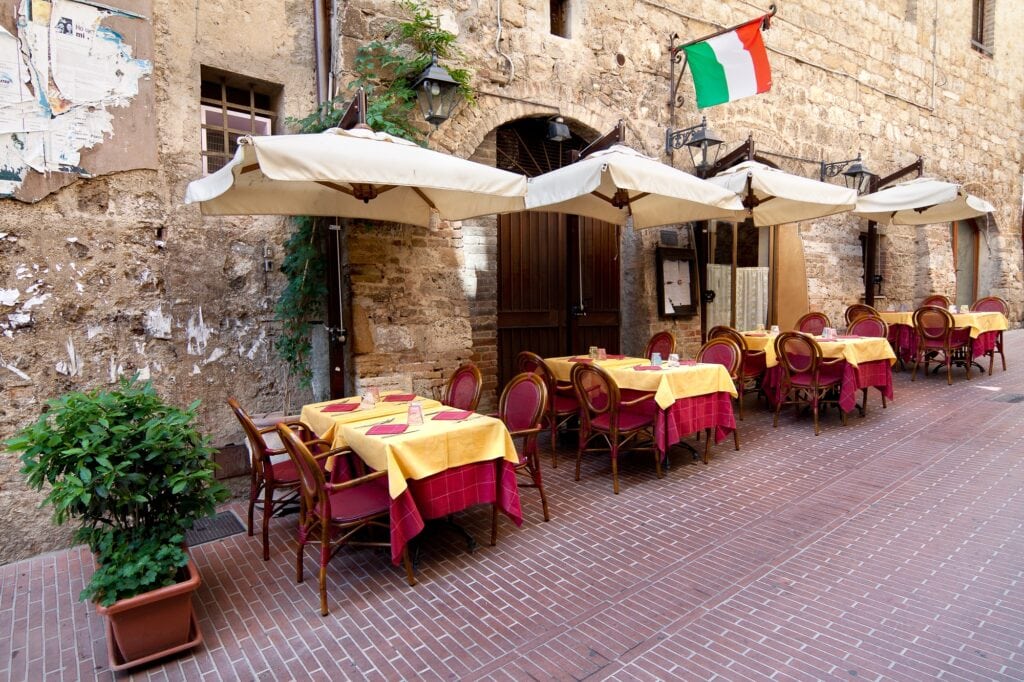
From savoring homemade pasta dishes to indulging in freshly caught seafood along the coast, every region in Italy has its own unique culinary specialties. Whether you’re dining in a bustling trattoria in Rome or enjoying a leisurely meal at a family-run osteria in Tuscany, eating like a local offers a glimpse into the authentic flavors of Italy.
In this article, we’ll explore the art of eating in Italy like a local, including tips on ordering, dining etiquette, and must-try dishes. Get ready to tantalize your taste buds and experience the true essence of Italian cuisine.
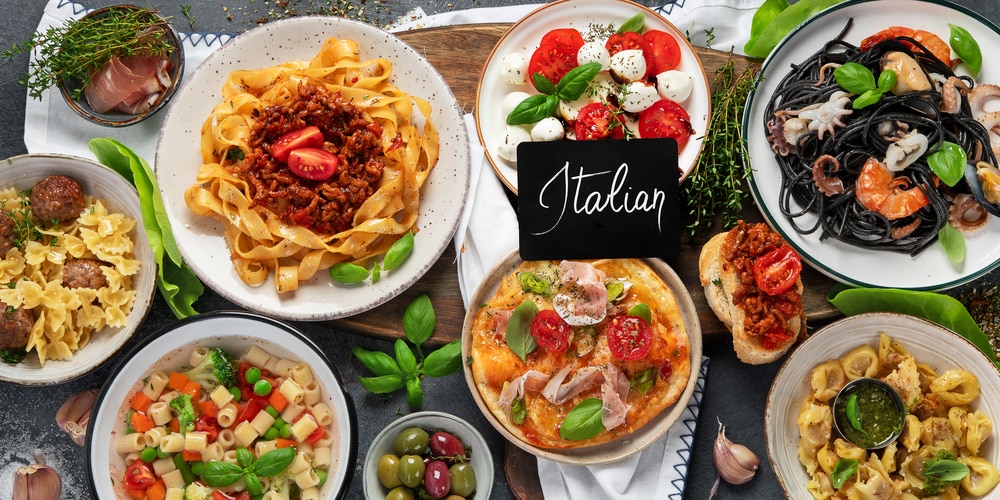
Food in Italy entails learning about the rules for ordering from an Italian menu and Italian dining. You should also learn about what types of produce and specialities an area is known for and enjoy the local specialties. For example, Calabria is known for its sweet red onions they are the pride and joy of Tropea. Cipolle hangs at vegetable stands, lie stacked by the side of the road and salads come bursting with sweet, raw, red Tropean onions.
If you are looking for some great beach time and seafood head to Sardinia which is where the Italians go for their summer holidays. The traditional food of Sicily is a combination of many cultures and flavours inspired by Spanish, Greek, and Arab cuisines.
A trip to Italy isn’t complete without a visit to Tuscany and enjoying some of the best Italian food and Italian meals ever. Tuscan cuisine, which you can find when you spend time in Florence is known for its wild game, rabbit and duck a famous dish you must try in Florence is Bistecca Fiorentina.
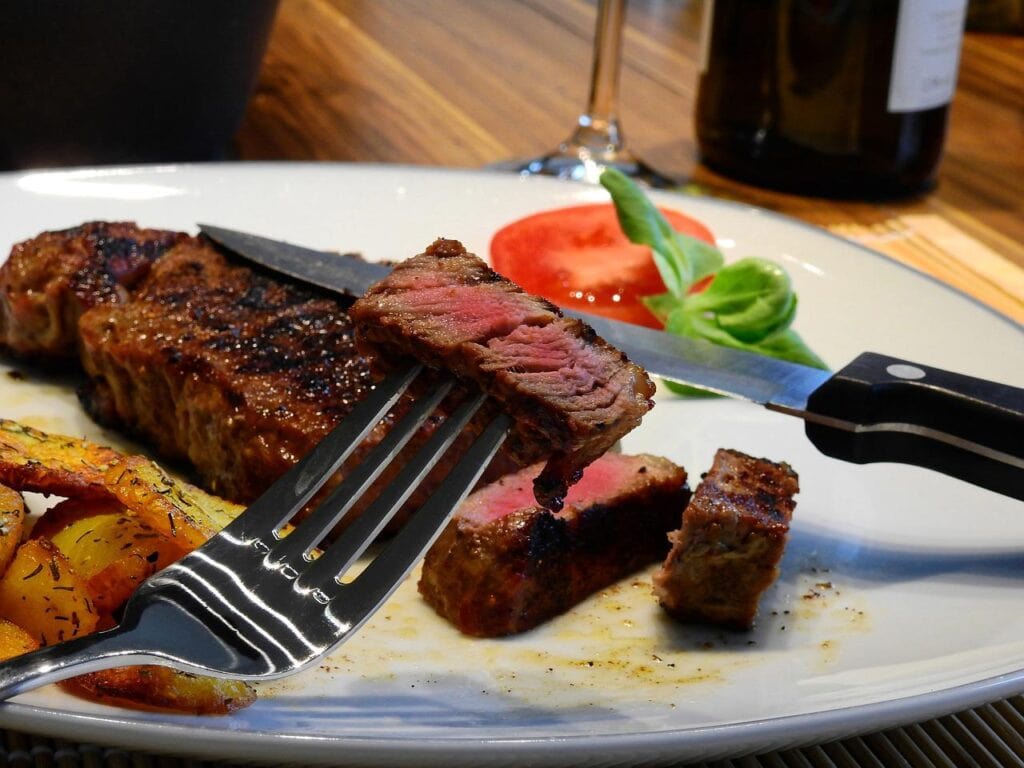
In Northern Italy Venice is another Italian destination that’s been on my bucket list for years. With its location on a lagoon and the Adriatic Sea, the range of seafood is outstanding there are many must-try foods in Venice. One thing remains the same though the Italians do not eat the same way the rest of the world does.
If you love your bread and pasta then it must be a Puglia road trip for you. Puglia is farm country and famous for its olive oils, grano arso a burnt wheat flour and my personal addiction Burratta cheese.
There is a pasta museum in Rome that I want to visit called the Museo Nazionale della Paste Alimentari (the National Museum of Pasta). Rome’s most common pasta shape is spaghetti.
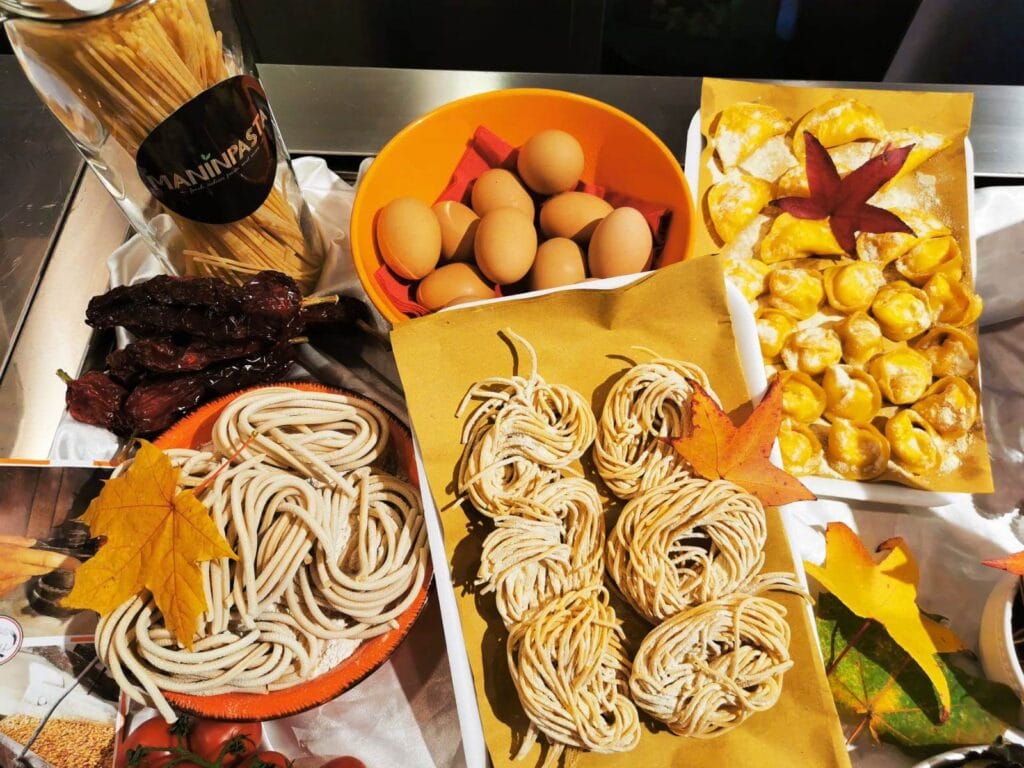
Pros and Cons of moving to Italy the ultimate guide
- Eating in Italy: 26 Tips for Eating the Italian Way
- Eating in Italy like a local
- Guide to Italian food Phrases
- How to eat in Italy – the courses on a menu in Italy
- Essential Tips for Eating in Italy
- What not to eat in Italy – What do Italians eat? Do's and Don'ts in Italy
- Don’t ask for “fettuccine alfredo” or “spaghetti with meatballs”
- No such thing as Chicken carbonara
- Don't order Garlic Bread
- Chicken parmesan doesn't exist in Italy
- No Marinara
- Italian Wedding Soup – doesn't exist here
- Italian Breakfast – Italians don’t eat eggs in the morning
- Cappuccino is only for breakfast
- How to order and drink Coffee in Italy
- There is no coffee to go
- Italians and tea
- Bread at dinner
- Know your peperoni from your pepperoni
- All fruits and vegetables must be peeled
- There is no salad dressing
- Olive Oil is a condiment
- Wine or water?
- No Doggy Bags Allowed
- Cheese does not go on every dish
- Ask for your bill, when you want it
- Tipping in Italy
- Avoid a menu in English or with photos
- Eating Pizza in Italy
- Eating in Italy food tours
Xyuandbeyond is reader-supported. When you buy through links on our site, we may earn an affiliate commission. You can read my privacy policy here.
Eating in Italy like a local
1. How can I eat in Italy like a local?
To eat in Italy like a local, it’s important to immerse yourself in the Italian food culture. This means embracing the idea of enjoying multiple courses during a meal, savoring each dish slowly, and engaging in lively conversations with your dining companions.
2. What are some tips for eating in Italy?
Some tips for eating in Italy include trying traditional Italian dishes, ordering what’s listed on the menu in Italian without being too picky, and not rushing through your meal. Also, refrain from asking for substitutions or modifications to dishes, as they are usually prepared in a specific and traditional way.
3. What is typically included on an Italian menu?
An Italian menu usually consists of several courses, starting with antipasti (appetizers), followed by a first course of pasta or risotto, then a second course of meat or fish, and ending with dolci (dessert). It’s common to enjoy a cappuccino after the meal.

4. How can I order pizza like a local in Italy?
To eat pizza like a local in Italy, opt for authentic pizzerias that serve pizza al taglio (pizza by the slice) or wood-fired oven pizzas. Italians usually enjoy their pizza in the evening as a complete meal rather than just a snack.
5. What should I know about the Italian food culture?
The Italian food culture revolves around fresh and seasonal ingredients, simplicity in preparation, and a focus on quality rather than quantity. Italians take great pride in their regional cuisines, so exploring northern and southern Italy will give you a true taste of the diverse Italian culinary landscape.
6. How do Italians typically eat lunch?
Italians often enjoy a leisurely lunch consisting of multiple courses, starting with antipasti, followed by a first and second course, and ending with a light dessert or espresso. Lunch is seen as a time to relax and socialize with friends or colleagues.
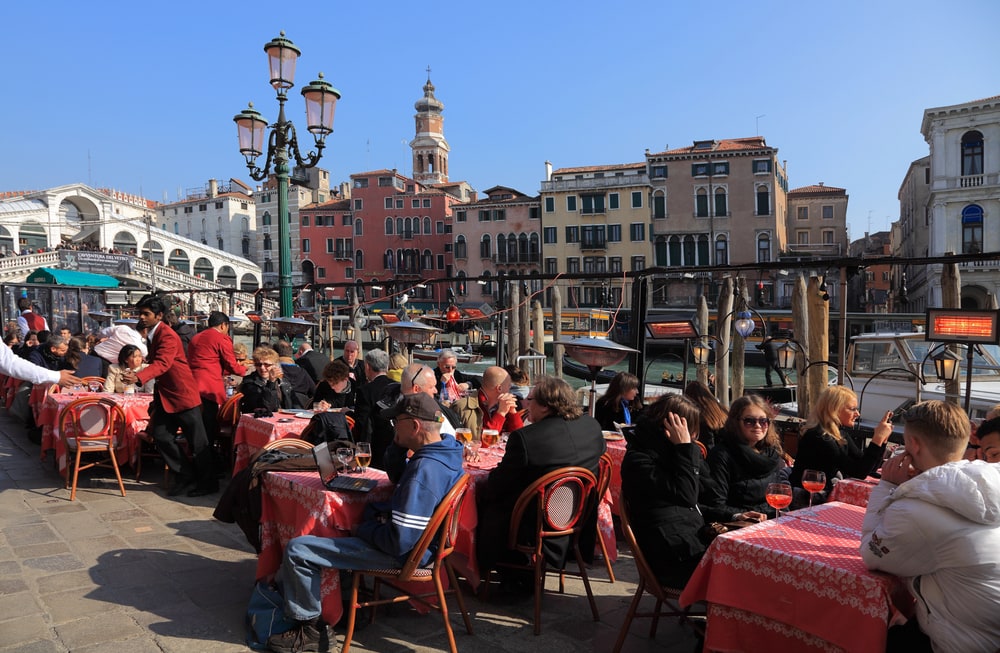
Guide to Italian food Phrases
Dining in Italy and food is very important in Italy not only the traditions of food and what you are eating but the eating itself is imbued with meaning. These are some of the phrases you will hear in Italy around food
- “hai, mangiato?” – meaning did you eat in Italian
- “mangiare” is simply eat in Italian
- “Mangia” is of course eat in Italian
Like many areas across Italy, there are regional differences and Rome is only one of the hundreds of Italian cuisines. Northern Italian cuisine differs in many ways and Rome may be over 9 hours away from Palermo but the food of this region is world-famous for its gelati and canoli, and its trattoria.
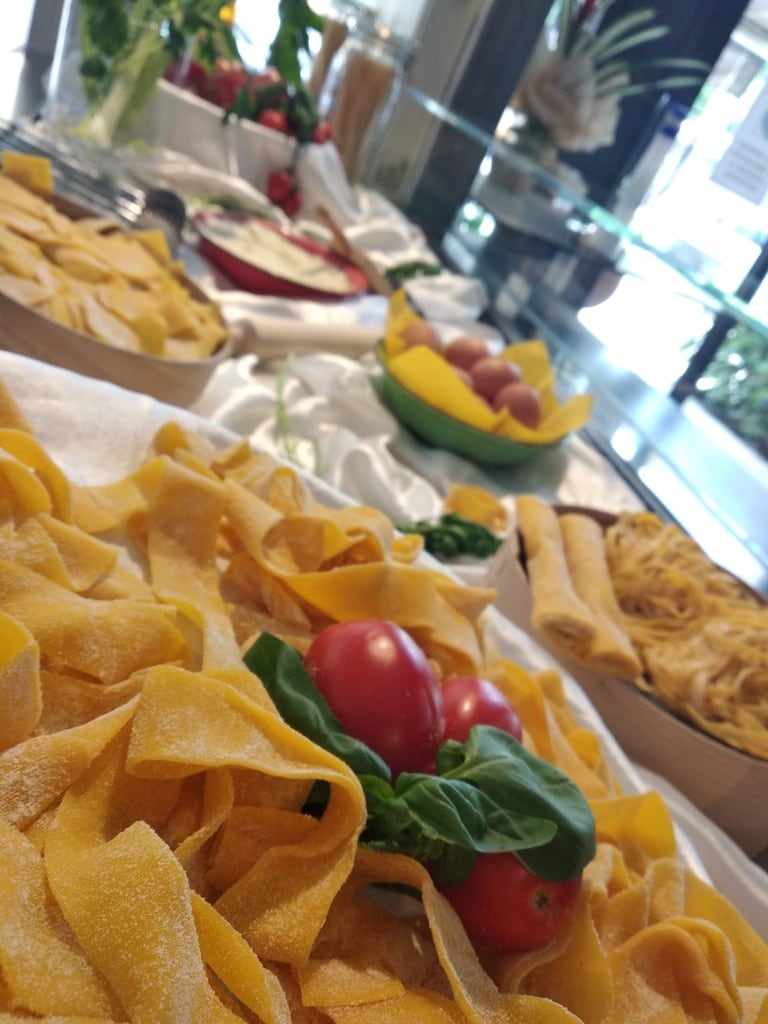
How to eat in Italy – the courses on a menu in Italy
In Italy, there are usually several courses to a meal and there are many Italian food facts that a visitor should know before they visit and get those sideways looks. Do not feel like you need to order every course though take your time pick what you like and enjoy.
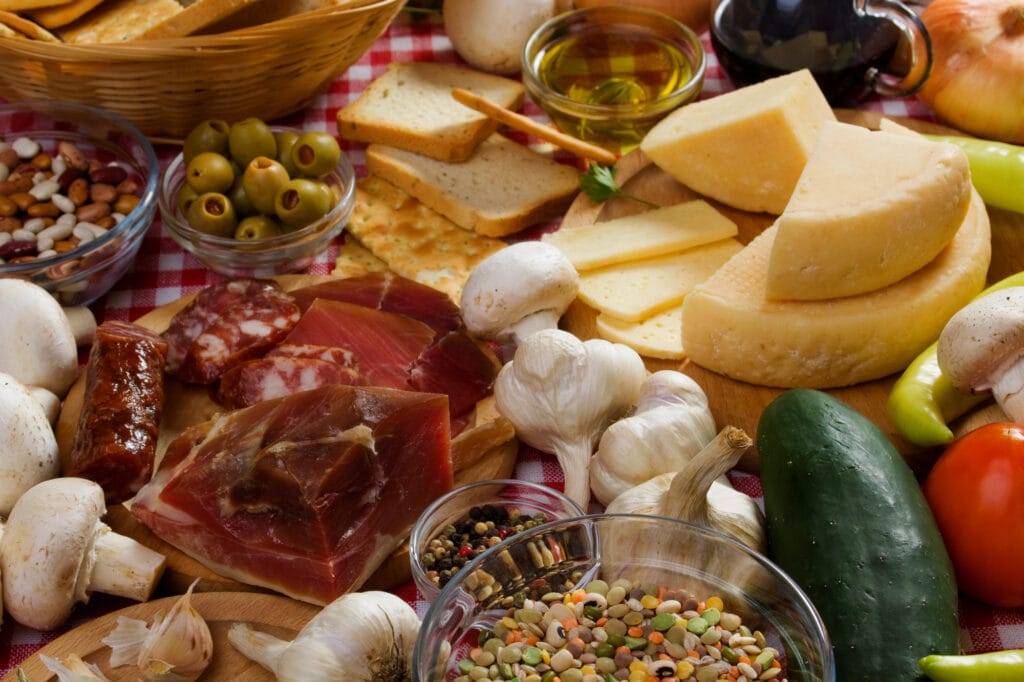
Antipasto
Antipasto simply means an appetiser, antipasti means multiple items. This may include means appetisers, and the singular form of the word is antipasto. You might see a selection of olives, cheese, sliced meats or possibly a salad.
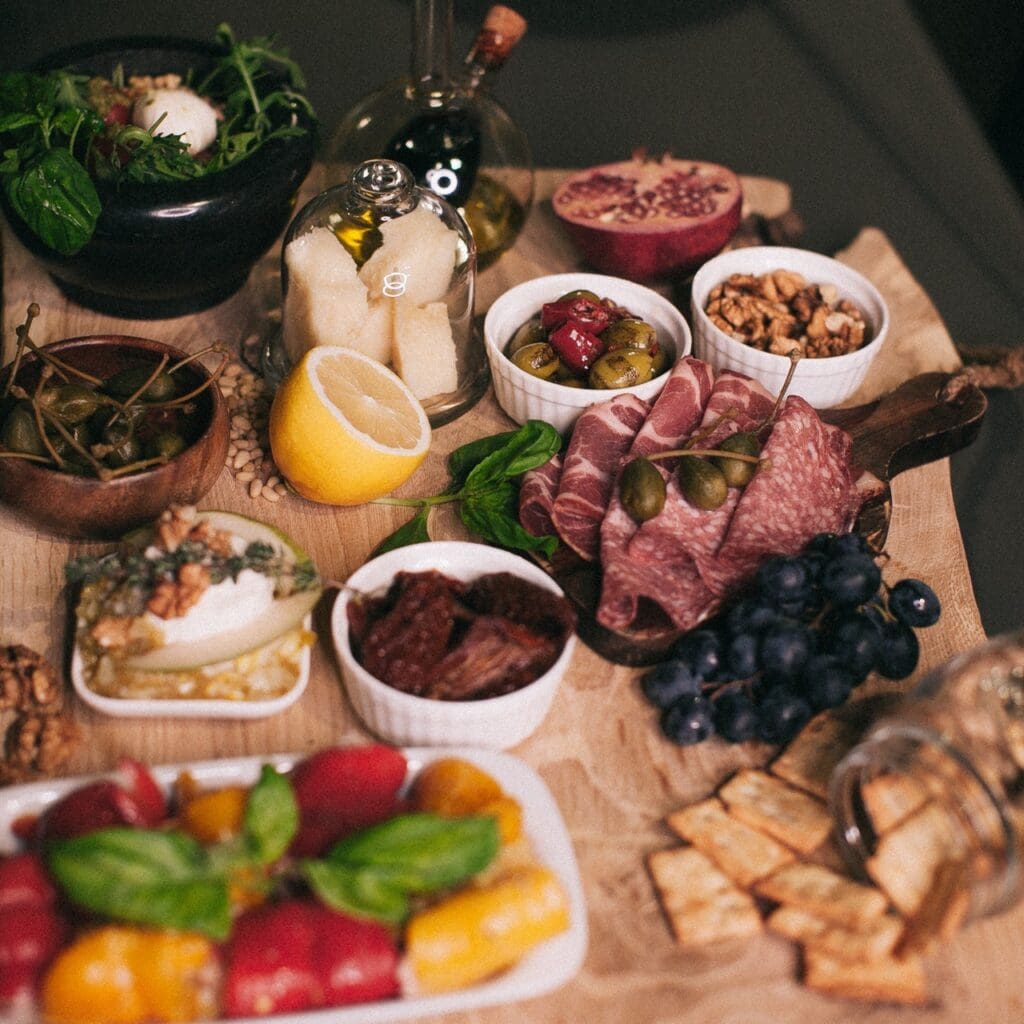
Primo / minestre
This is the first or main course and where traditionally a plate of pasta or soups and rice dishes are served. Ministre usually means a liquid so a soup or Zuppa would be served.
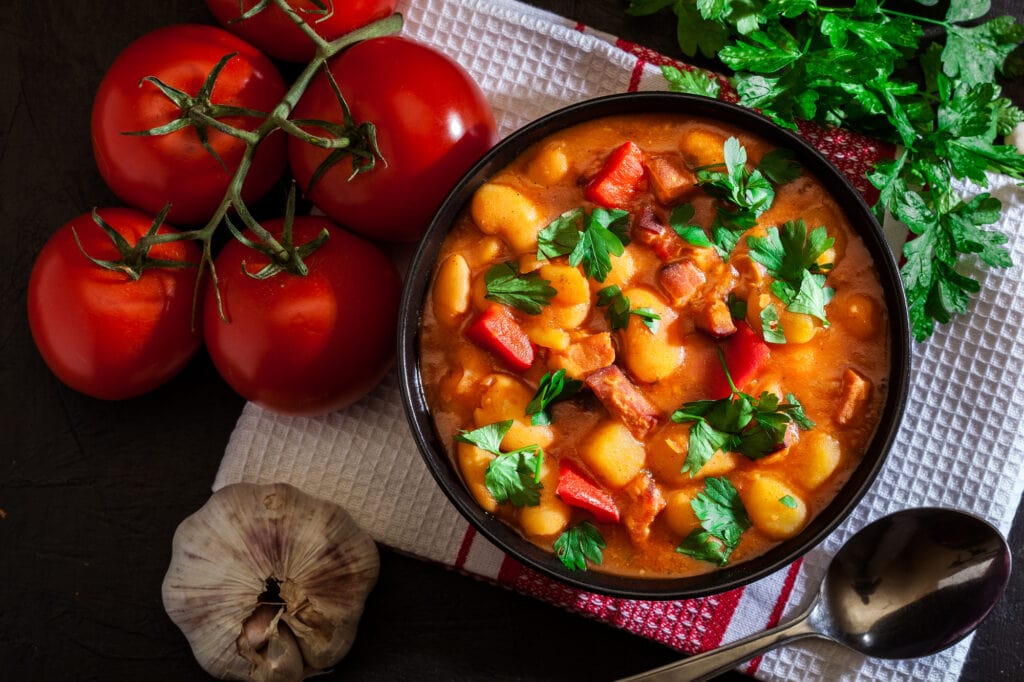
Secondo
Obviously, the second course will usually contain a fish, meat, egg or cheese dish. It won’t arrive with any vegetables or side dishes as it would in N. America so it may not be as substantial as you are used to.
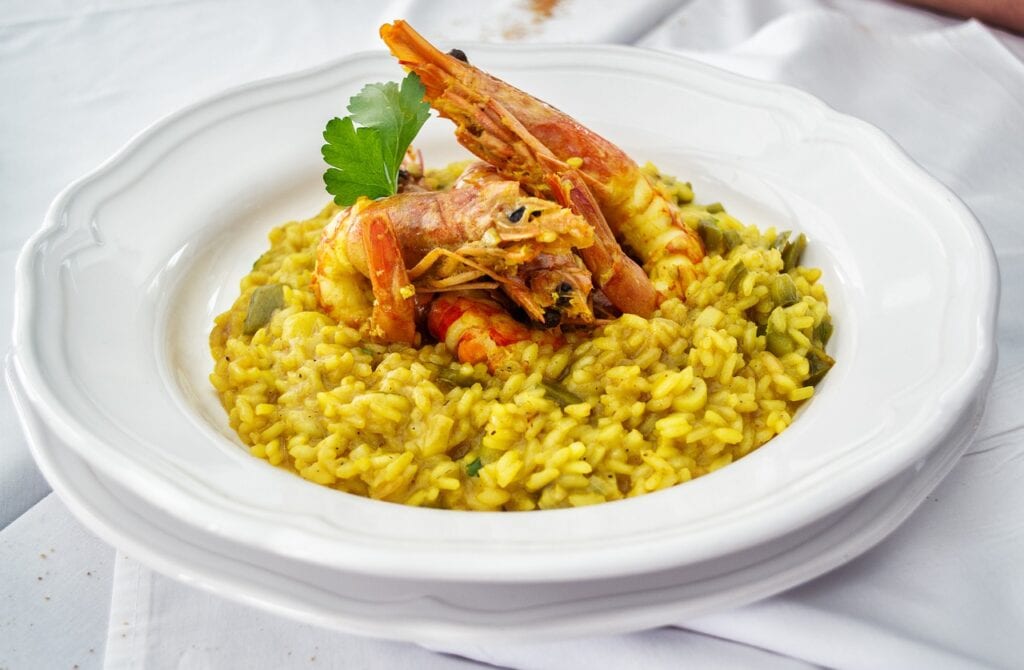
Contomi
Contomi are side dishes. These should be ordered with your secondo and they will include boiled oven-roasted and grilled vegetables. These are traditionally very simple if you order for example Puntarelle, a salad green that is curly and mixed with an anchovy dressing. A very seasonal dish in Roman cuisine.
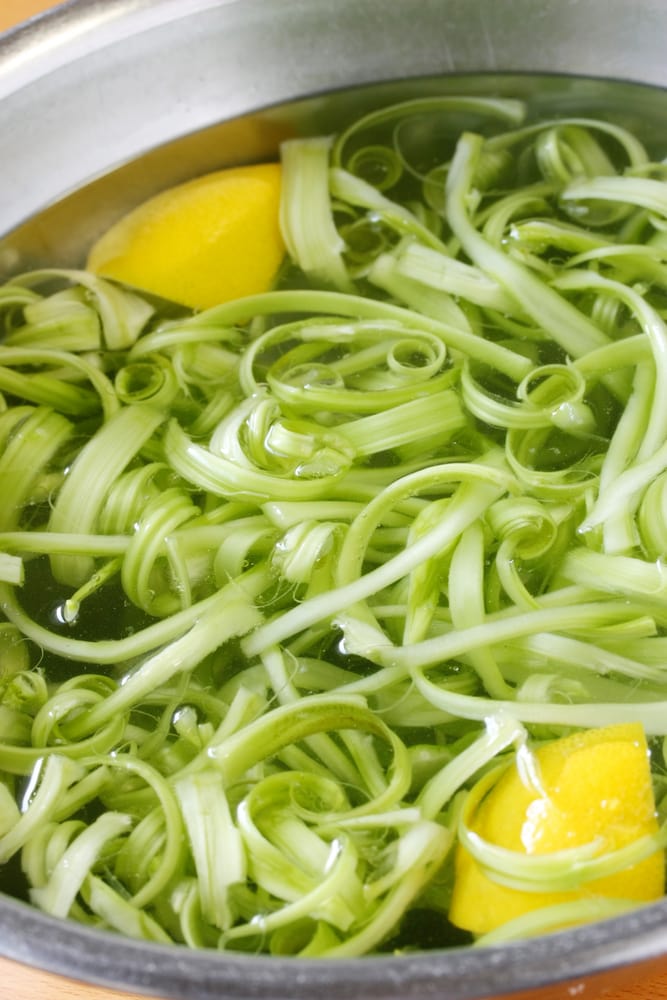
Dolci
Ah, Italian desserts! Gelato, pannacotta, mascarpone cream, cakes, tiramisu so much to choose from. Coffee is not served with dessert but always after and it must be an espresso served piping hot.
Romans do not eat all those courses though they tend to limit themselves to around 2 per meal but if you are starving you can go ahead and have one course of each.

Aperitivo
We learned quickly when living in France about Aperitivo and the Italians are also famous for this practice. Aperitivo is a serious business and to many Italians, it is the most important part of the day, particularly on Fridays and the weekend.
Aperitivo is the time Italians connect with family and friends. There is usually a drink involved – wine or prosecco and it is accompanied by “stuzzichini”, or as we know them appetizers in France they are called charcuterie. The trays of small snacks include some great cheeses, meats like Parma Ham and porchetta, bread and no butter.
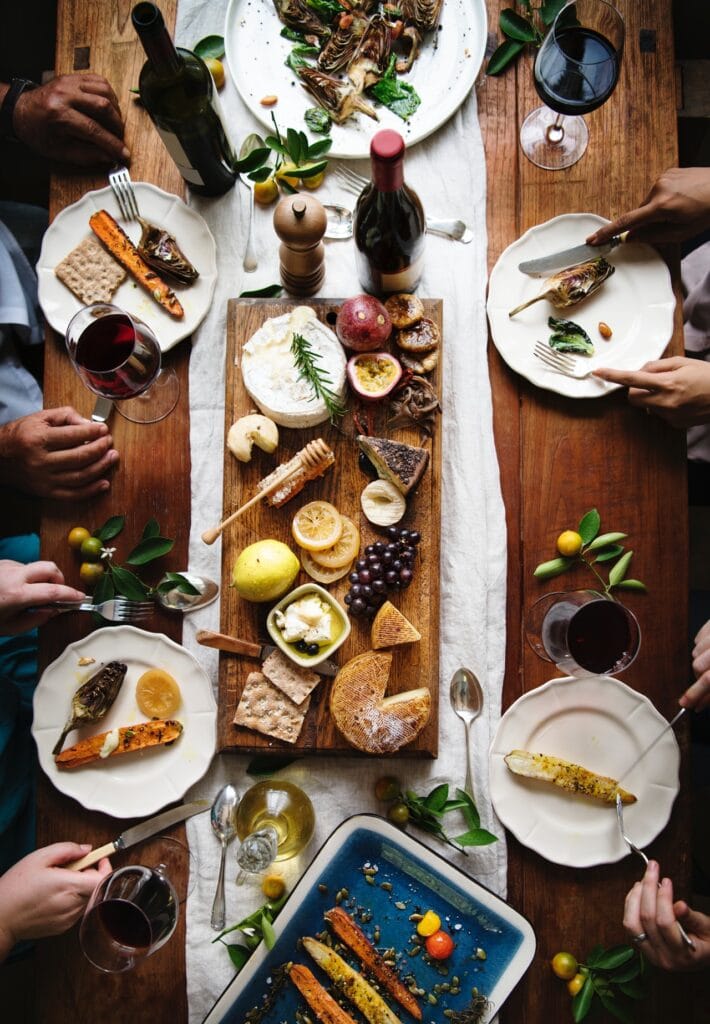
Essential Tips for Eating in Italy
What do Italians eat for lunch?
Italians prefer to sit down and eat lunch which consists of a primo (pasta, soup or risotto dish), a secondo (meat or fish-based dish) and a contorno (side dish). In Italy, lunch or il pranzo, is usually served and eaten from 12:30 to 2:30 pm. Although, most Italians will eat their midday meal promptly at 1:00 pm every day and enjoy a relaxed 1.5 hour minimum lunch time.
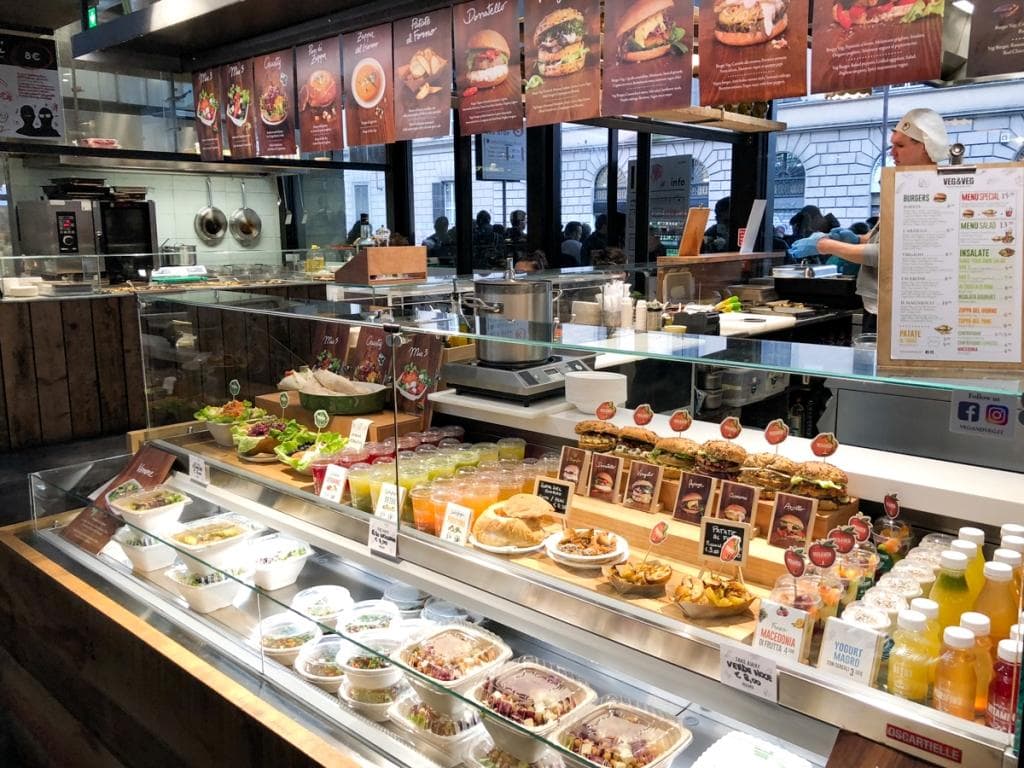
Closing times for lunch in Italy
Even in the twenty-first century, many Italian businesses and tourist attractions close at lunchtime, it’s important in Italy that all workers get a chance to sit down and enjoy their lunch. In major cities, you won’t find much of this but in the smaller towns and villages, you will see that museums, tourist sites, shops and pharmacies will close for lunch. In the warmer months, many places will stay open later so shoppers can shop without the daytime heat.
Meal times in Italy
Italians eat 4-5 times a day:
- breakfast in Italy is early in the morning and consists of pastries, bread with butter and jam, biscuits and cereals
- there’s a morning snack around 11 am (for some it’s just a coffee break);
- lunch in Italy is between 1 and 2 pm, and is usually at least an hour long;
- the afternoon snack is around 4 -5 pm (again, for some it’s just a coffee or tea);
- between 6 and 7 pm, it’s aperitivo time: something to drink (alcoholic or not), a snack like nuts or olives, and an excuse to meet friends after work or on weekends. This is not an everyday custom, but a pleasant exception.
- An Italian dinner is around 8-9 pm (a little earlier if you go North, a little later if you go South).
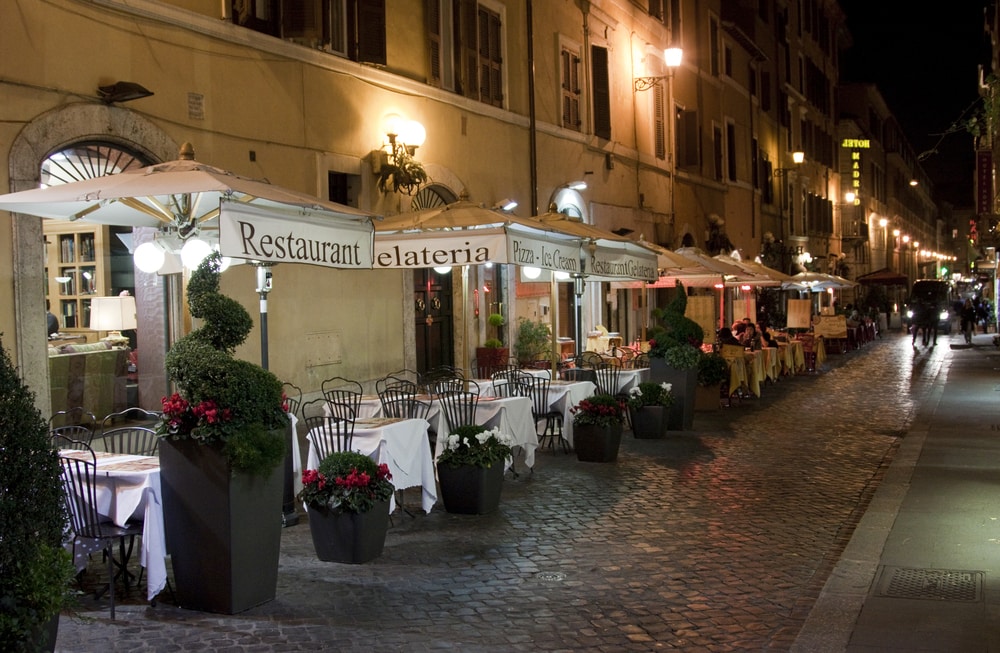
What not to eat in Italy – What do Italians eat? Do’s and Don’ts in Italy
Don’t ask for “fettuccine alfredo” or “spaghetti with meatballs”
They don’t exist here. Alfredo was invented by an Italian in Rome for his pregnant wife suffering from morning sickness. The simple pasta with cream sauce and butter is not served at any restaurant in Italy except for Alfredos in Rome.
Spaghetti Likewise, spaghetti is not served with meatballs. In Naples, you’ll find miniature ones on other types of pasta. Everywhere else, pasta al ragù (with meat sauce) is a common first course, and “polpette” (meatballs), are a typical – separate – second course. If you’re way ahead of me and already thinking, “I’ll just ask for both those things and mix them together,” you can certainly do that. But…reread the title of this article first.
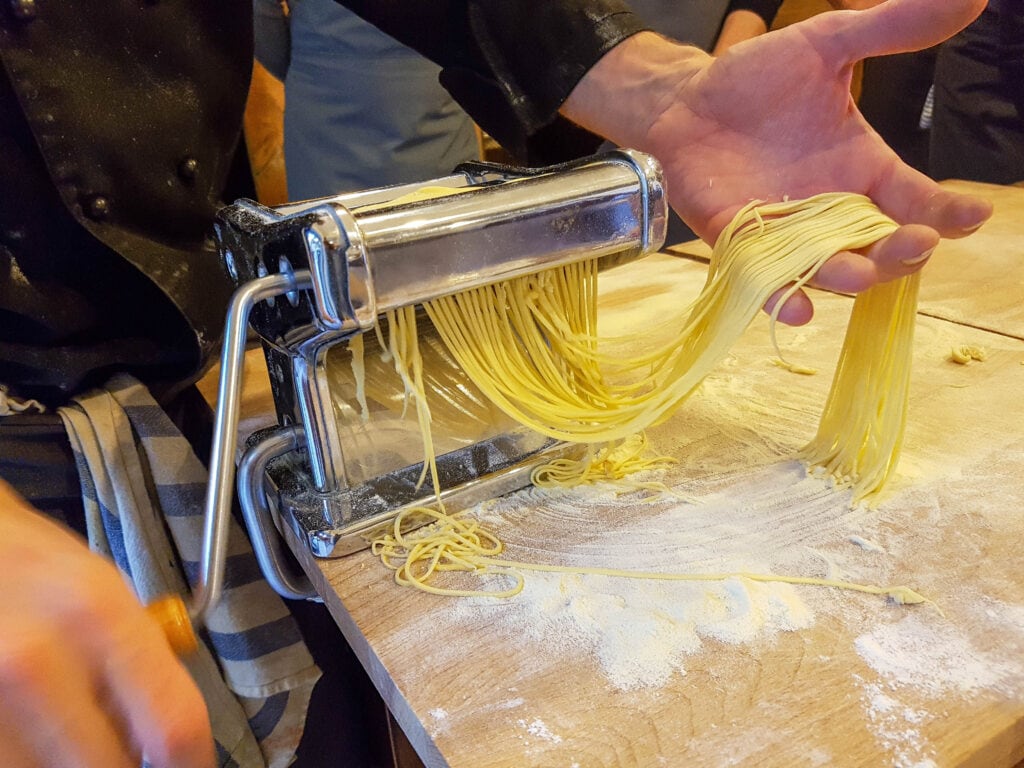
No such thing as Chicken carbonara
There is only one Carbonara in Italy and it only contains eggs, a good aged hard cheese like Pecorino, black pepper, and guanciale, which is browned pork cheek.
Don’t order Garlic Bread
Garlic bread does not exist in Italy the closest you will get is a fresh bruschetta.
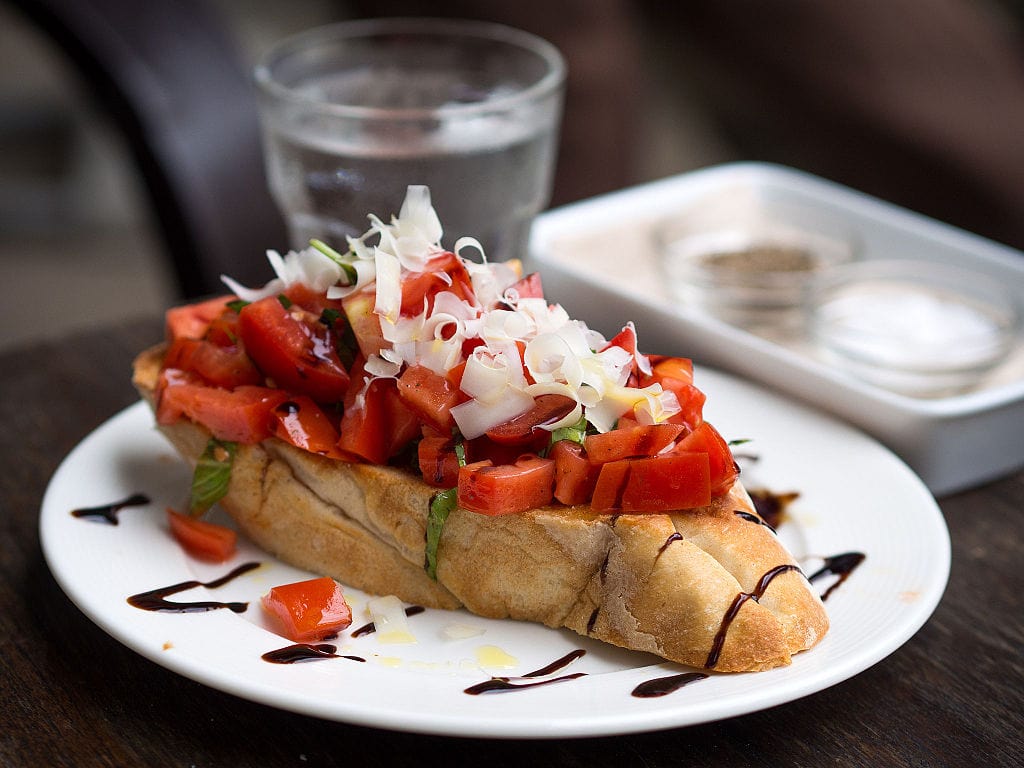
Chicken parmesan doesn’t exist in Italy
Just like the chicken carbonara, chicken parmesan just does not exist in Italy. It was created in the US and has never been imported in Italy or exported from Italy.
If you want a cream sauce look for Panna or cream on the menu. Pasta is served al ragù(with meat sauce) for primo or first course but “polpette” (meatballs), are typically served for secondo.
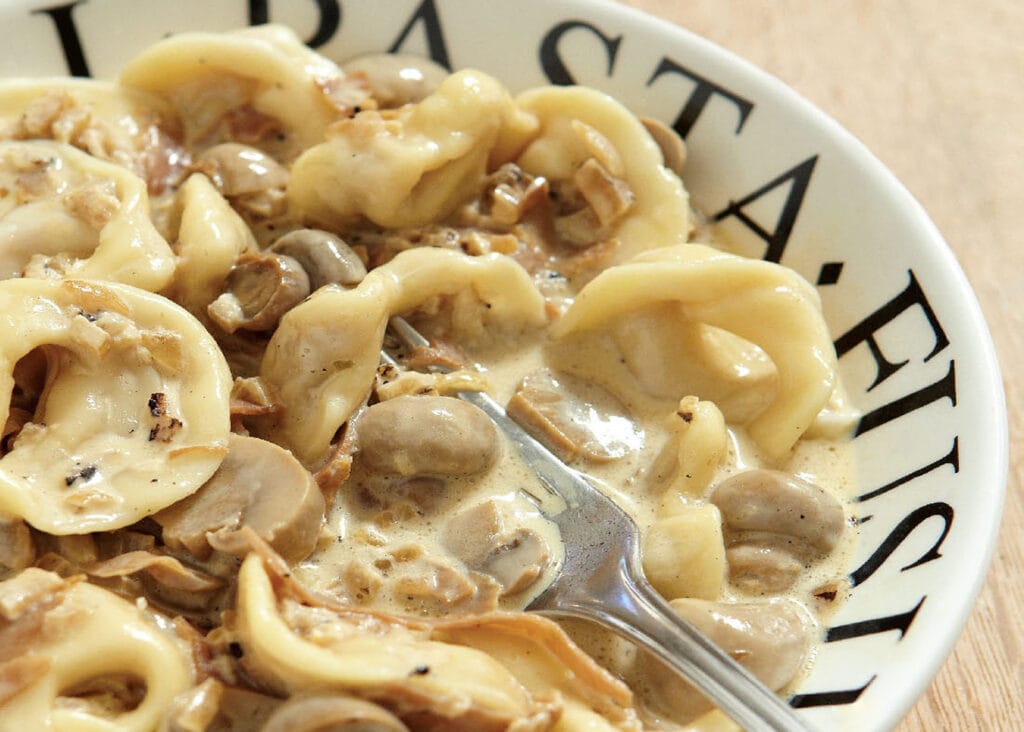
No Marinara
Marinara is usually found in countries outside Italy but here it is not a traditional Italian sauce. Marinara usually means a pizza made with a simple tomato sauce, olive oil and oregano.
Italian Wedding Soup – doesn’t exist here
This is a completely made-up soup from North America and yes it has pasta, spinach and Italian sausage but it’s just not Italian.
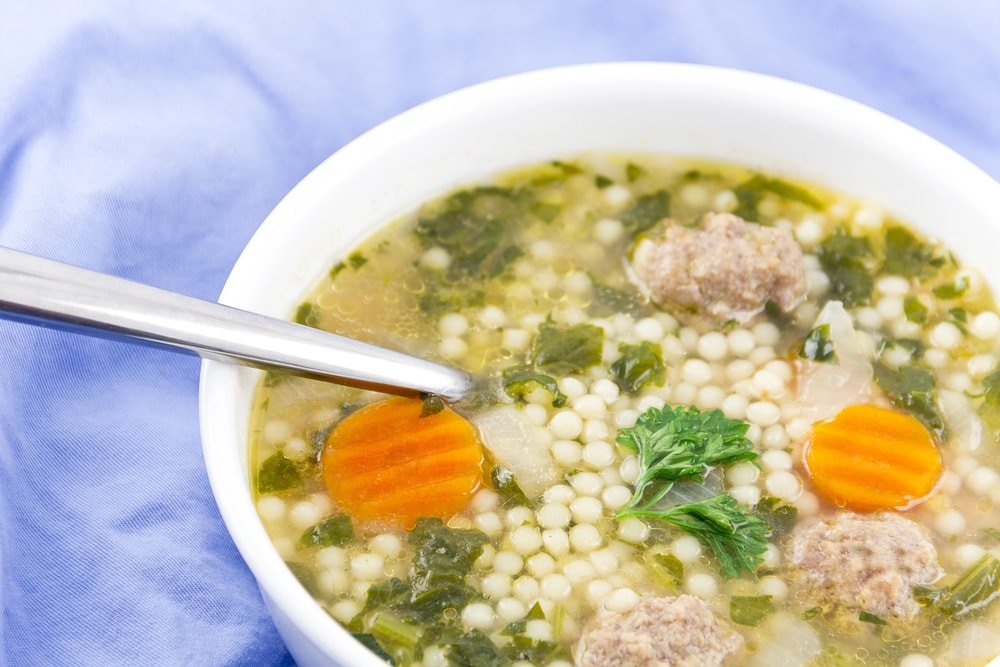
Italian Breakfast – Italians don’t eat eggs in the morning
Typically for breakfast, an Italian will have a strong espresso and a sweet pastry. If you need something more substantial try a ham and cheese toast at a local “caffè“ or “bar” as cafes are known here.
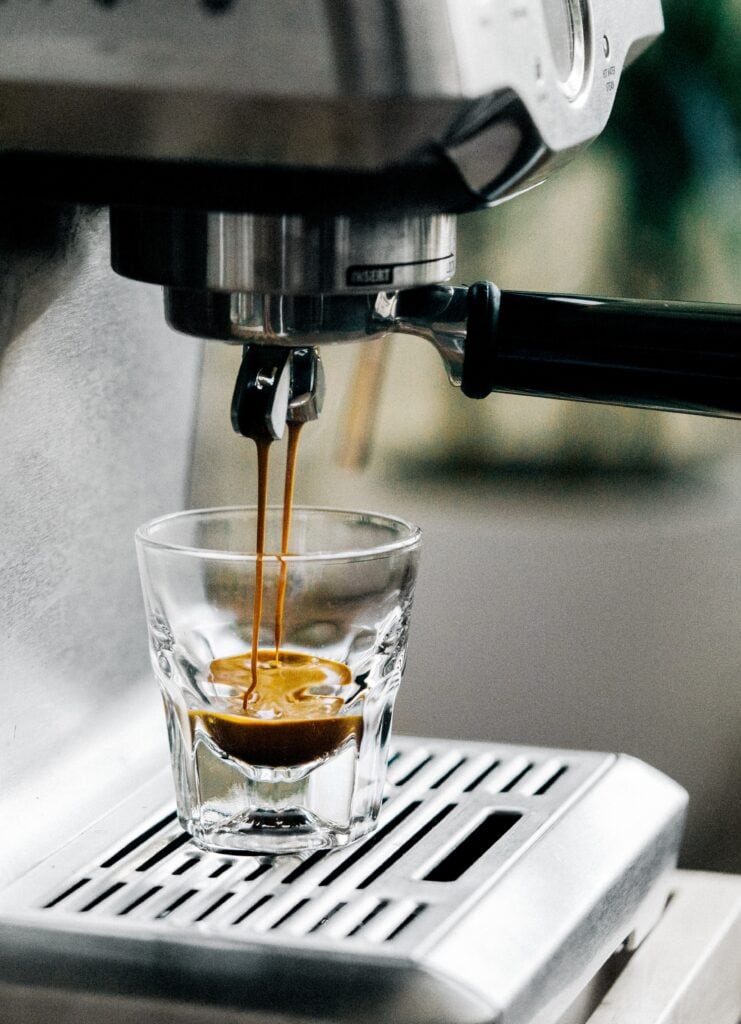
You will find many of the hotels in Rome do serve an “American style breakfast” or have a buffet to please their tourist guests but Roman dishes do not include breakfast.
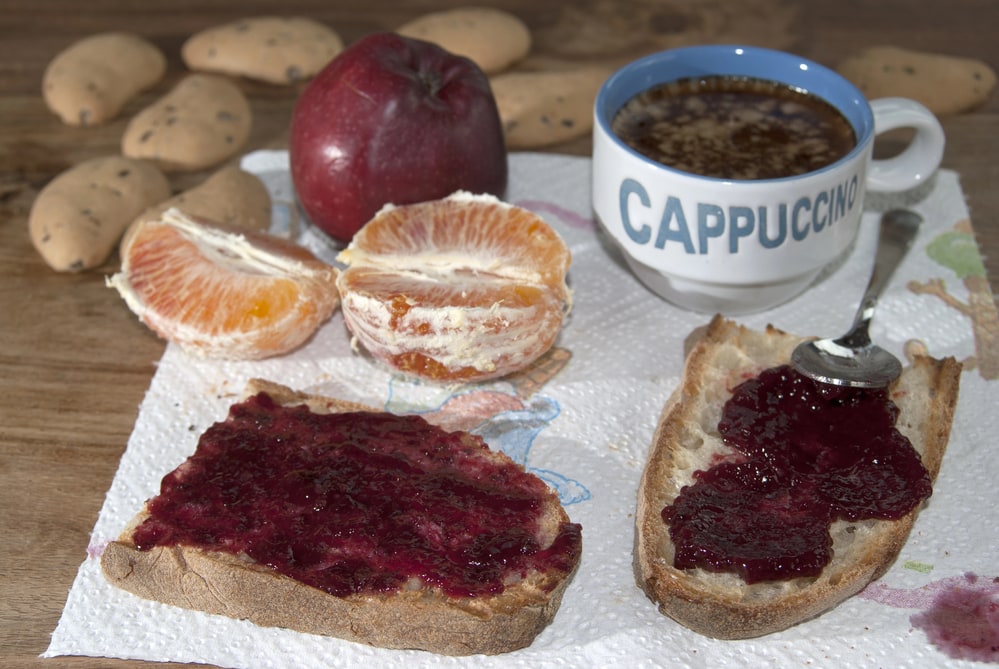
Cappuccino is only for breakfast
Italians would never order a cappuccino at any other time of the day and they certainly wouldn’t drink it with a meal so lay off the cappuccino. After a lovely meal, Italians will order a Caffe or macchiato.
Cappuccino is considered too heavy after a filling meal. In addition, it’s common for restaurants to offer diners a complimentary digestivo liqueur – anything from limoncello to Sambuca. Italians believe that digestivi aid post-dinner digestion. You can even order a Caffe Corretto – a shot of espresso spiked with liqueur.

How to order and drink Coffee in Italy
When you head to an Italian cafe for your coffee you head into the cafe and order if it is not breakfast time you will order an expresso and pay at the register. You then take the receipt to the barista who will give you a glass of water – I’ve often seen tourists looking at the water thinking what the heck? The water is to cleanse your palate to enjoy your coffee.
When the coffee arrives you continue to stand at the bar to drink it along with your food if you have ordered any.
There is no coffee to go

In Rome drinking coffee is considered a pleasure to be savoured. You won’t find a “to go” cup in most Italian cafes. You should be aware though that Italian cafes offer different prices depending on whether you sit at a table or stand at the coffee bar. These prices are noted on the menus: banco is standing and tavolo is sitting.
Italians and tea
In Italy, tea is mostly associated with the flu (influenza) or a cold (raffreddore). Hot tea and honey (Miele) are popular during flu season, but that is it.
Bread at dinner
Don’t do what most of us N. Americans attempt to do what we learned from the crappy Italian bistro on the corner. In Italy, you do not sit down for dinner take some bread and dip it in the olive oil and balsamic you have put on your plate.
This just isn’t an Italian food tradition. Bread is used in Italy to act as a utensil to sop up all that lovely saucy goodness left on your plate. It’s often called fare la Scarpetta or the little shoe it picks up the bits that your fork can’t get. You would never find an Italian eating bread with their pasta and you also won’t find butter here to slather on your bread.
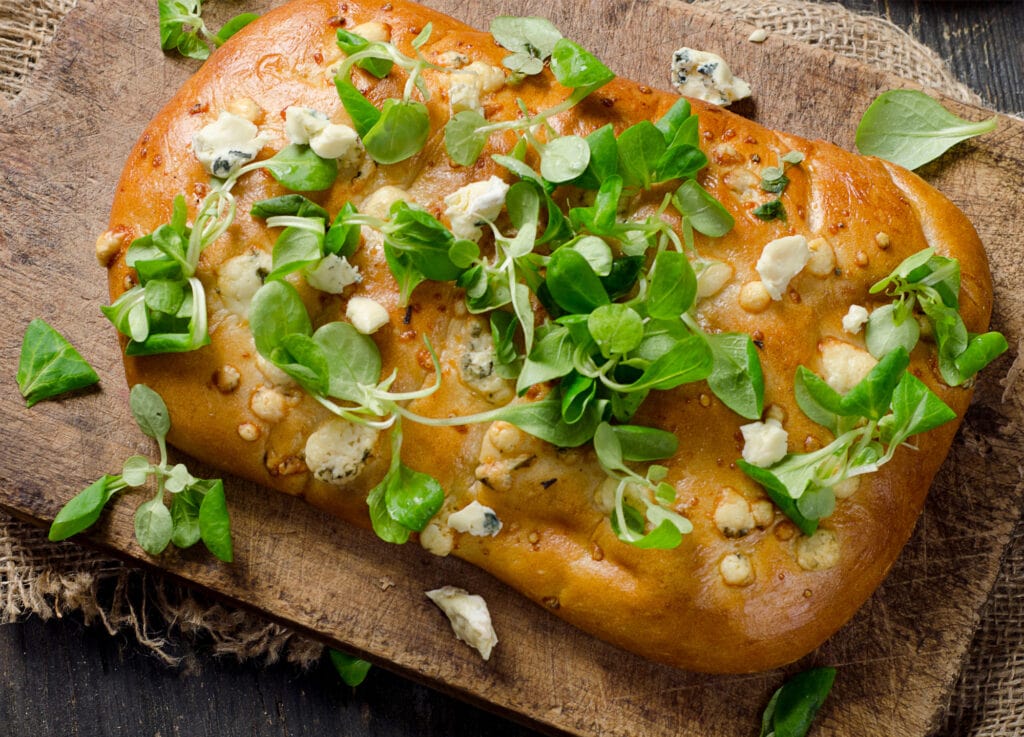
Know your peperoni from your pepperoni
In Italy, peperoni is the plural of bell pepper so watch your pizza order. Go for Pizza al Salmino, or Pizza Diavolo or Calabrese but warning they will be spicy.
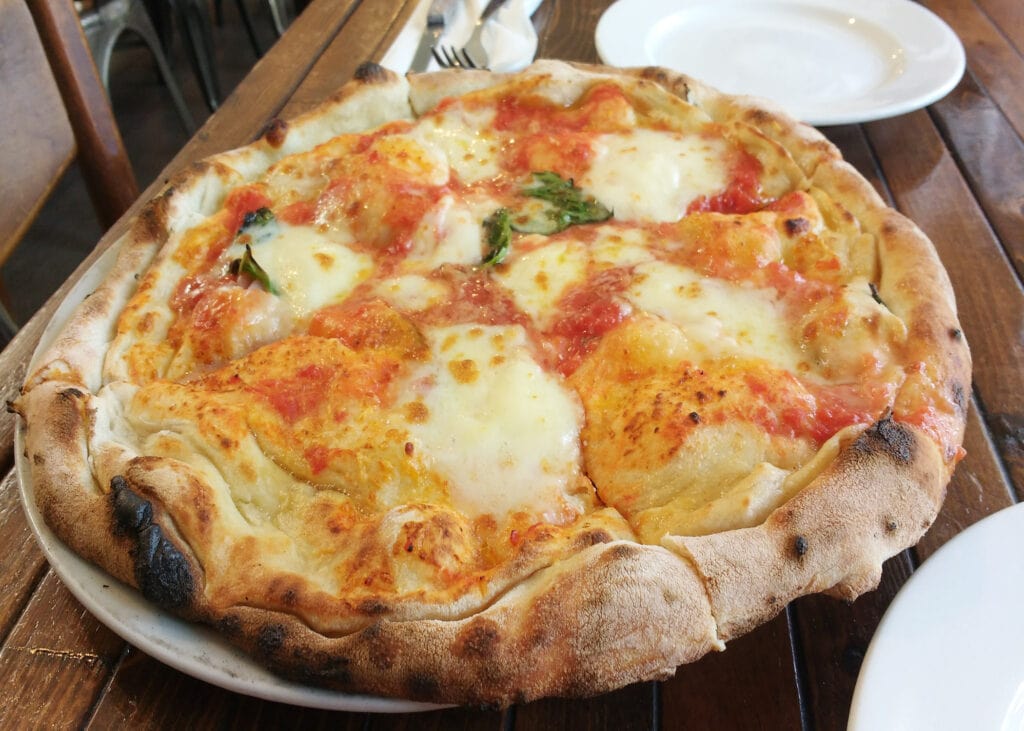
All fruits and vegetables must be peeled
Particularly when served as a fruit platter, small sharp knives are provided and the Romans are very proficient at peeling without looking.
There is no salad dressing
Nope, don’t ask for it, no Caeser, no Ranch, no Italian or French it just doesn’t exist. What you will find dressing your salads is beautiful fresh Olive Oil and maybe some fabulous Balsamic vinegar.
Olive Oil is a condiment
Italians love to taste what they eat so you won’t find salad dressing as above, ketchup, BBQ sauces, mayo on your sandwiches or brown sauce on your potatoes. Italy is a condiment-free world. Oh, they can be bought but the Italians just don’t use them unless it’s olive oil.
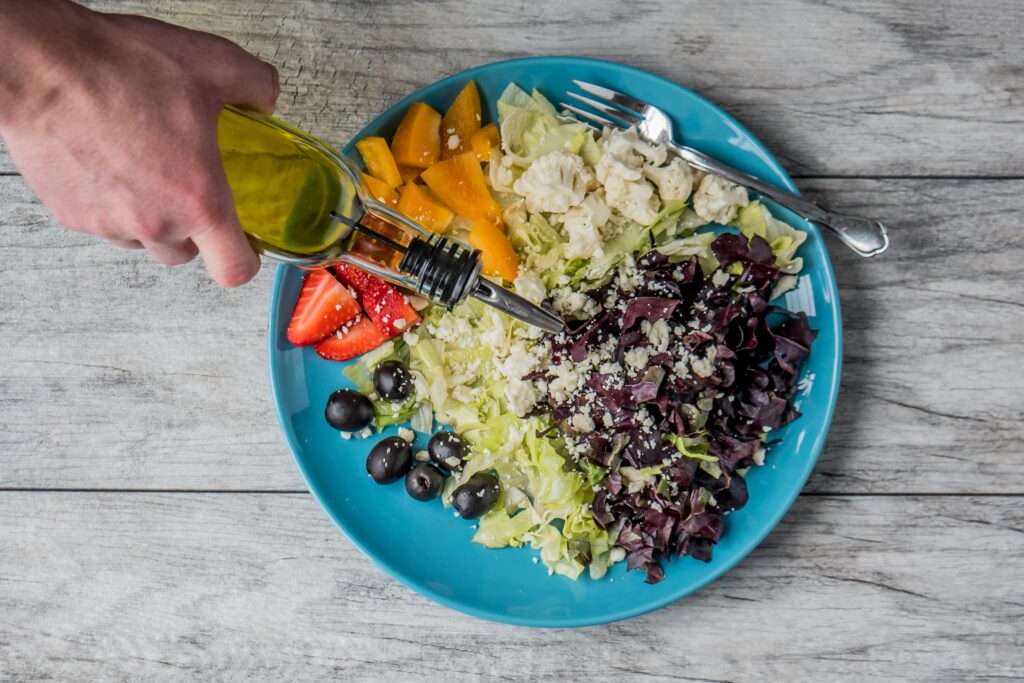
Wine or water?
In Rome and the rest of Italy, the table will be set with a bottle of still or sparkling water and of course a glass of house wine. Italians do not drink pop, soda, coffee, ice tea and so on with dinner. Well, not unless it is pizza and then beer or Coke is acceptable. Cocktails and liquors are reserved for: aperitivi (before-dinner drinks) and digestivi (after-dinner drinks). Although Italian tap water is fine to drink it is not served in restaurants or cafes.
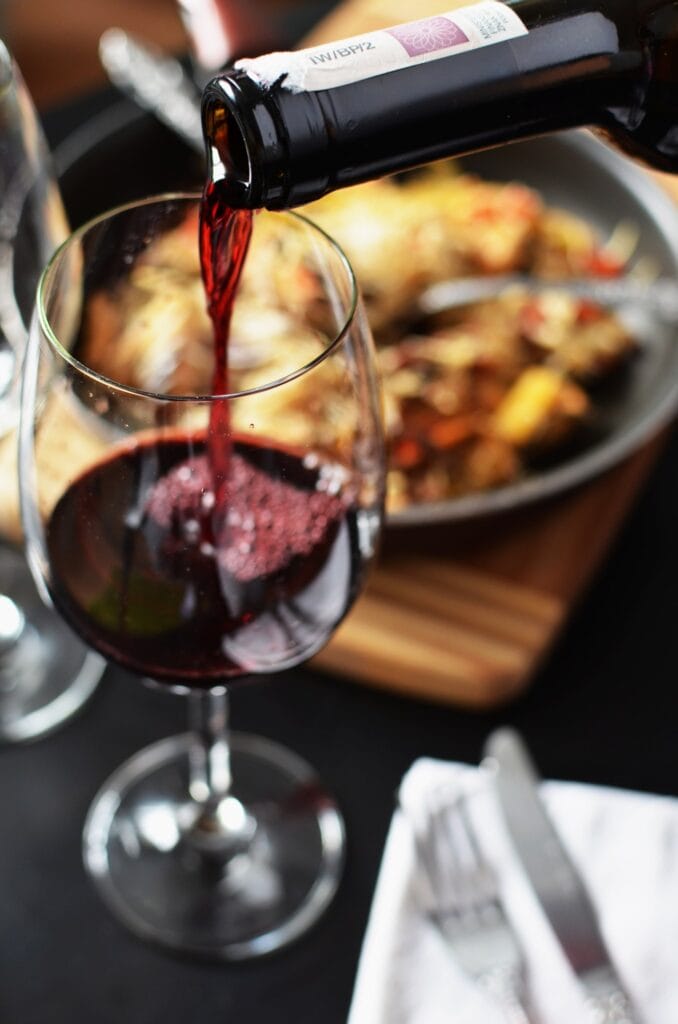
No Doggy Bags Allowed
In Italy, the food must be fresh, hot and made with love Italians do not eat leftovers and until 2016 an Italian restaurant did not have to provide one. These days you can ask but don’t expect to be provided with one.
Cheese does not go on every dish
There are only a few dishes that need or will be served with cheese in Italy. Pasta dishes that can be added to with cheese will include carbonara or egg pasta with meat sauce. Do not ask for extra cheese and do not expect to find the Parmigiano Reggiano on the table to help yourself this just isn’t done in Italy.
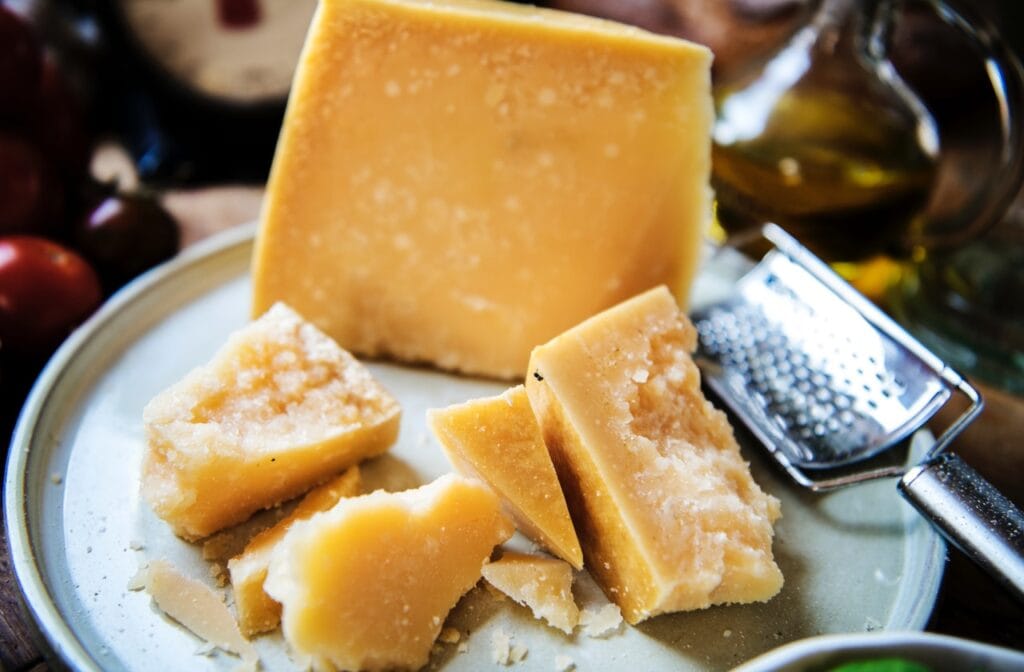
Ask for your bill, when you want it
Don’t expect your bill when you have finished your meal Italians take their time and enjoy the meal and the moment and the waiters will not bring your bill until you request it. They expect you to take your time.
Tipping in Italy
You don’t need to tip in Italy. Most bills will include a supplement charge or a Servizio (service charge) on your restaurant bill and/or the coperto (cover charge), sometimes both and waiters here are quite well paid and respected. However, having said that it is always good to round up the bill and leave the extra for the hard-working staff.
Avoid a menu in English or with photos
In Italy, these kinds of poster menus written in English with photos will more than likely serve crappy food at a significantly higher price. As a quick guide, a pizza Margherita should cost no more than 8 euros and the average price for a cappuccino in Rome should be around 2.80 euros.
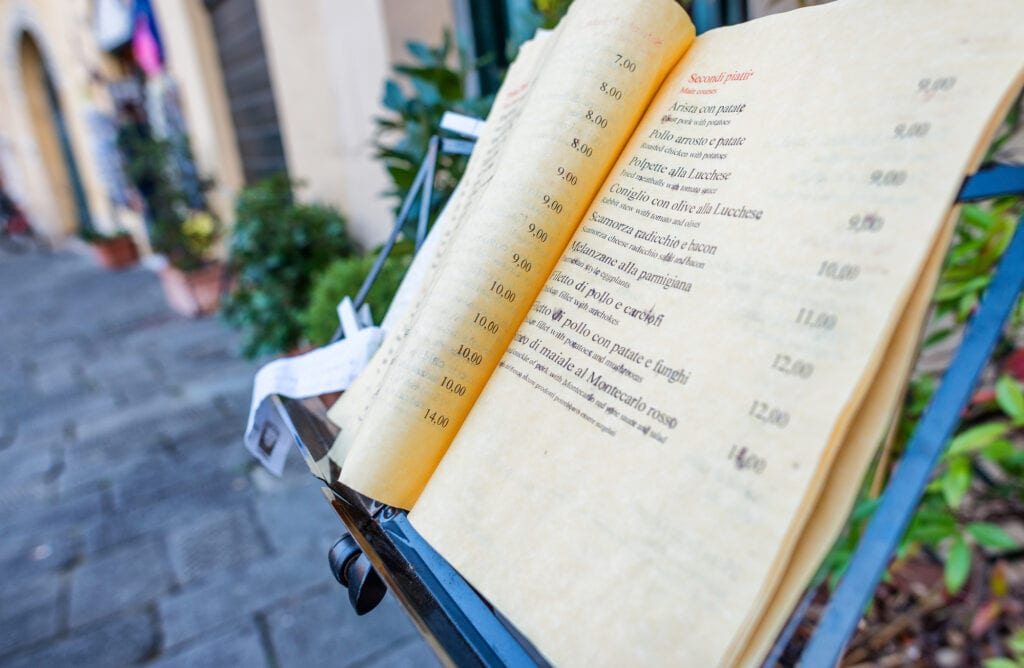
Eating Pizza in Italy
Italy offers sauce that many Americans might not be used to. Instead of slow-cooked tomato sauce like we offer here in the US, Italy uses olive oil, pureed fresh tomatoes, garlic, and oregano. This gives their pizza a herby taste that U.S. consumers may not come across often. You also eat your pizza with a knife and fork in Italy.
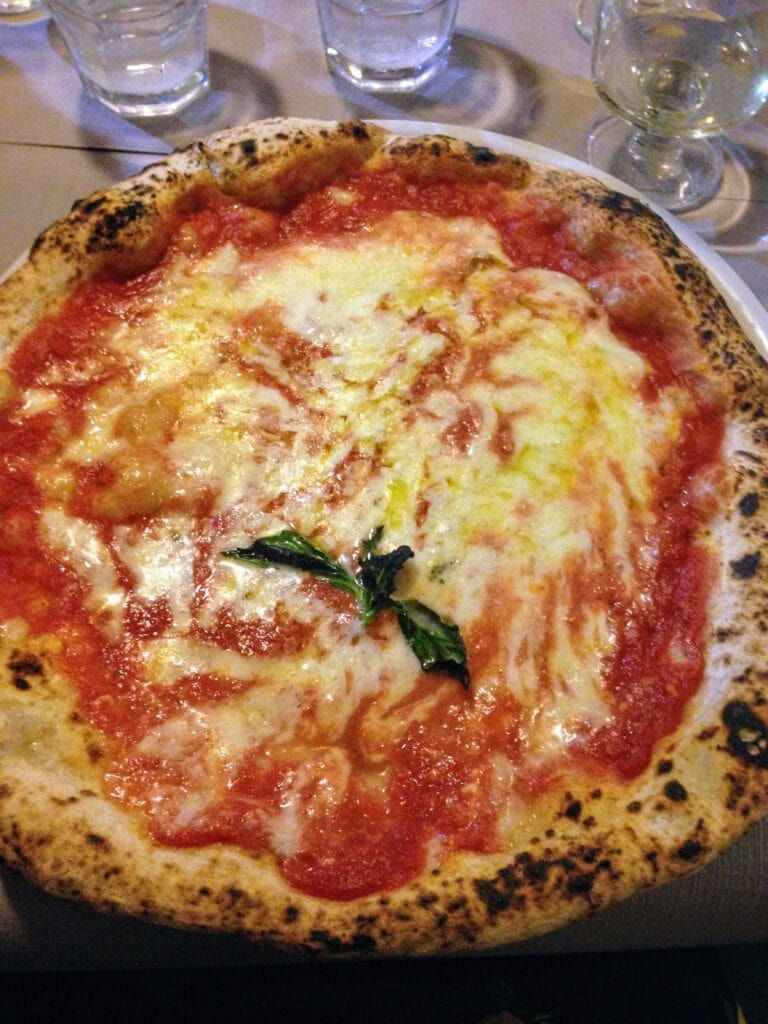
Eating in Italy food tours
Food tour in Rome
Go on the hunt for some of the best food in Rome on this culinary walking tour through the areas of Campo de Fiori, Trastevere, and the Jewish Quarter. With a guide, learn the local secrets of the Eternal City and sample traditional Italian favourites like gelato and pasta, as well as local specialities like fried artichokes. Limited to 12 people, this tour offers a more personal sightseeing experience. Rome food walking tour to Trastevere, Campo de’ Fiori, and the Jewish Ghetto Visit Campo de‘ Fiori’s market to meet local traders and sample their quality produce Explore vibrant Trastevere and try food like a classic Roman pasta dish, gelato, and pizza.
Read more about Small-Group Rome Food Walking Tour: Trastevere, Campo de’ Fiori, Jewish Ghetto
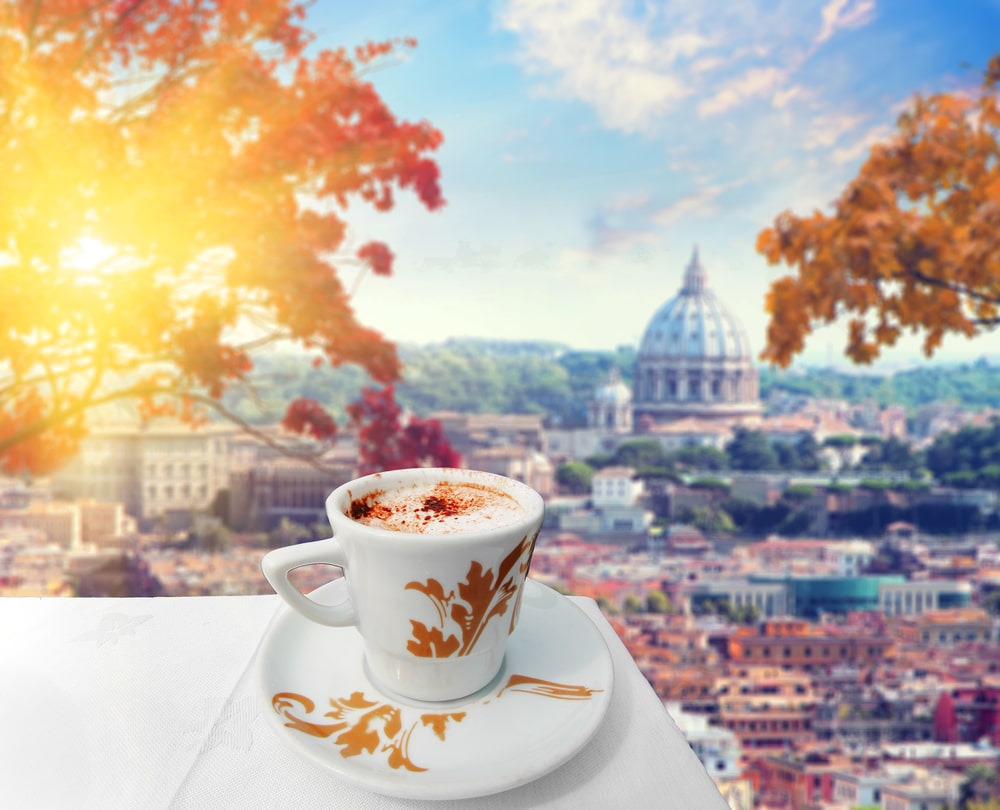
Food Tour of Florence
Get an insider’s perspective on Florence’s vibrant food scene and Italian culture during this scenic tasting tour through the Tuscan Renaissance city. Join your private foodie guide to go behind the scenes and discover the food favourites most beloved by locals. Sip on an authentic Italian espresso, haggle over fresh pasta at the bustling Sant’Ambrogio market, and sample regional delicacies like Tuscan street food and the best gelato in Florence.
Read more about The 10 Tastings of Florence With Locals: Private Food Tour
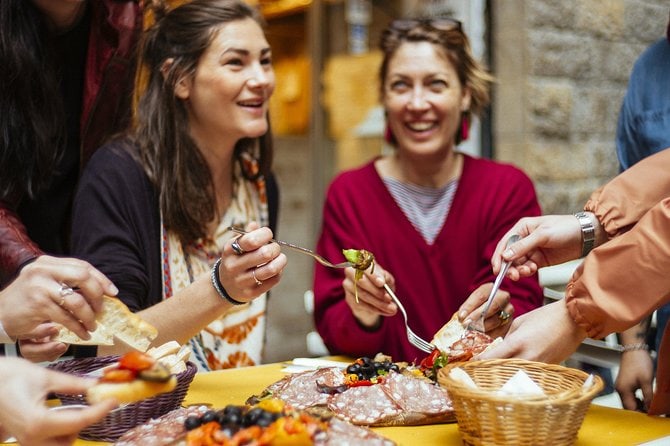
Pizza and gelato course in Tuscany: Learn to make pizza and gelato during this culinary experience on a Tuscan estate near Florence, perfect for lovers of culture and cuisine. Your professional Italian chef provides a fun hands-on cooking lesson that culminates in a 3-course feast of appetizers, pizza, and gelato, accompanied by wine and beer. Plus, you’ll receive a recipe booklet to take home and practice your newfound skills.
Read more about Pizza and Gelato Cooking Class in Tuscan Farmhouse from Florence
Naples street food tour: Get a true taste of one of Italy’s culinary capitals on a food and sightseeing tour of Naples. Spend some time exploring the city, stopping at the city’s main squares and basilicas, as well as at hidden eateries to sample traditional dishes. Learn the history of Naples as you make your way from one mini-feast to the next, dining on everything from zucchini flowers to ragù, baccalà, and pizza.
Read more about Naples Street Food Tour With Local Expert
When it comes to eating in Italy like a local, there are a few key things to keep in mind. Firstly, Italians tend to eat their largest meal at lunchtime, with dinner being a lighter affair. This is a stark contrast to the American tradition of having a big dinner in the evening. Additionally, Italians place a high value on quality ingredients and simple preparation, often opting for fresh and seasonal produce. This emphasis on freshness and simplicity is something that Italian immigrants brought with them to America, influencing the way many Americans now approach food. In conclusion, to truly eat like a local in Italy, it’s important to embrace the Italian way of eating – prioritizing quality, freshness, and simplicity in your meals.
buona mangiata – good eating
Have you been to Italy yet? What is your favourite Italian custom or food?
You might also like
Pros and Cons of moving to Italy
Calabria itinerary: Ultimate 5-day road trip Southern Italy
Exploring stunning Capri Italy
Best Things to do for 3 days in Rome
Food in Rome and Where to Eat in Rome
Beautiful bookstores in Europe including Italy
Stunning Amalfi coast to visit

